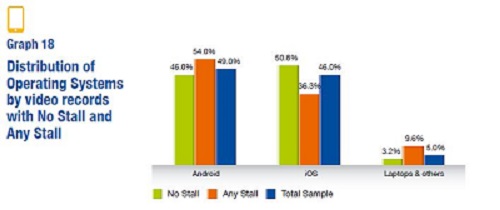Ever wonder if you are the only one having a less-than-wonderful user experience when watching video on a mobile network? Unfortunately, as we all know all too well, we are far from alone. However, have you ever wondered why this is so?
The answer to that last question is a bit complex, but Israel-based Allot Communications, suppliers of service optimization and revenue-generation solutions for fixed and mobile broadband operators, has released its February 2014 Allot MobileTrends Report, “Measuring the Mobile Video Experience,” which explores the factors that impact video delivery quality over mobile data networks. Here at the annual gathering of the global mobility community at the Mobile World Congress (News - Alert) in Barcelona, it has already gotten more than passing interest.
As noted, there are a lot of elements that can go into a bad experience, which come under the term “stalling”, i.e., what could be described as video interruptus. The report in fact details how download bandwidth, duration, resolution, mobile operating system (iOS, Android (News - Alert)) and video container (3GP, MP4) affect stalling, as well as how they interact to influence the overall video viewing experience. In terms of industry growth, understanding these factors and getting them corrected is going to be critical, especially given how much streamed video is already consuming huge chunks of operator bandwidth with less than favorable reviews.
Indeed, since mobile subscribers tend to evaluate the overall quality of their mobile network based on their video viewing experience, video stalling is a key consideration when users are selecting or switching services providers. The value of the report for service providers is a rather detailed demonstration of how video analytics can be used to address the issues identified in the analysis.
Allot notes that the statistical information in the report includes a randomly selected sample of 300,000 representative video detail records (VDRs) from hundreds of millions of unmanaged mobile video transactions during a given week. The source data was extracted anonymously from a mobile service provider in a developed country during December 2013.
Mobile Video Delivery - Key Findings:
- Actual bandwidth allocation by the network has no correlation to the video stream requirements.
- Laptops with dongles experience more video stalls than smartphones. However laptop users will continue to watch the video for longer durations, regardless of stalls.
- The video delivery container directly affects the mobile viewing experience.
- Insufficient allocated bandwidth for the video session will result in video stalls.
- Videos watched for longer durations are likely to have more stalls.
"Since customers tend to judge the quality of their mobile network based on the quality of their video viewing experience, it is crucial for mobile operators to be able to accurately measure the experience and better understand the factors that affect it,” said Andrei Elefant, VP of Marketing and Product Management at Allot Communications (News - Alert). “This report clearly demonstrates that video analytics together with video management and optimization tools can help mobile operators improve the video experience, thus making them more competitive.”
Illustrative of the type of information in the report that operators will find useful can be seen in the graphic.

Source (News - Alert): Allot Communications, February 2014 Allot Mobile Trends Report, “Measuring the Mobile Video Experience”
What the report shows is that if the mobile service providers want all of us to have a desirable user video experience, the industry has a lot (no pun intended) of work to do.
Allot has a few recommendations as to how to improve things:
- It is worth exploring the development and deployment of content-aware bandwidth allocation. It appears that bandwidth is allocated by other parameters and not necessarily the bandwidth needed by the content.
- Video delivery can be improved by methods that take into account the video container and the mobile device. This suggests a number of video optimization directions that operators can pursue.
- Granular and accurate video analytics are extremely important in order to find the root cause of stalling and to ensure quality of experience to subscribers.
While all of the above are important, the first two about content-awareness (I would actually call it applications awareness or applications fluency) and accounting for the container would be major steps in assuring that the experience I desire is the one I get, and that the bandwidth I am paying for is not being wasted on an imperfect experience.
If nothing else this report should serve as a call to action for the mobile service providers. With so much of their network traffic now being dominated by streamed video from the likes of Netflix and YouTube (News - Alert), they run the risk of stalling out a terrific revenue stream if they can’t fix the problems.
Edited by Rory J. Thompson





